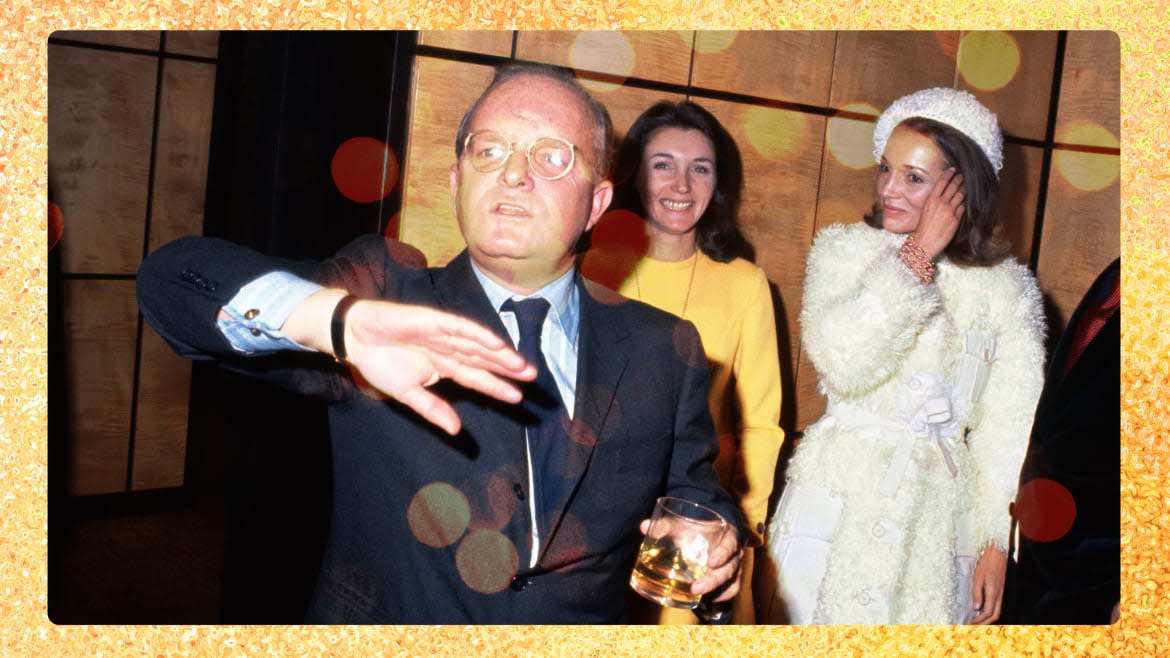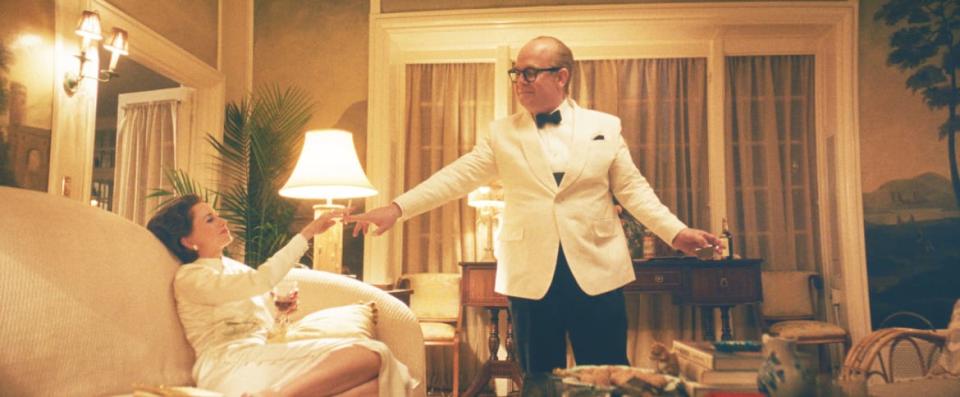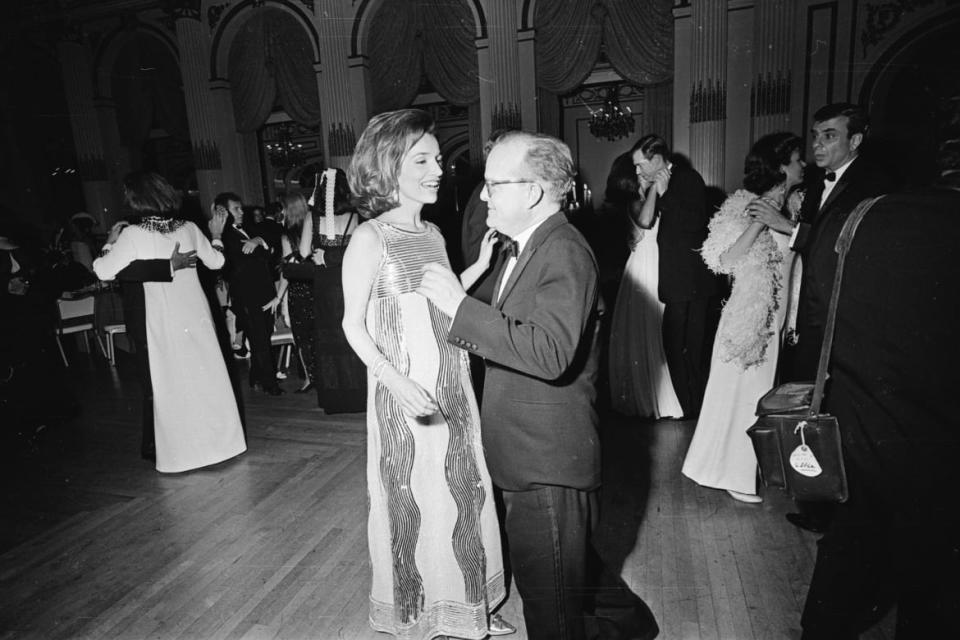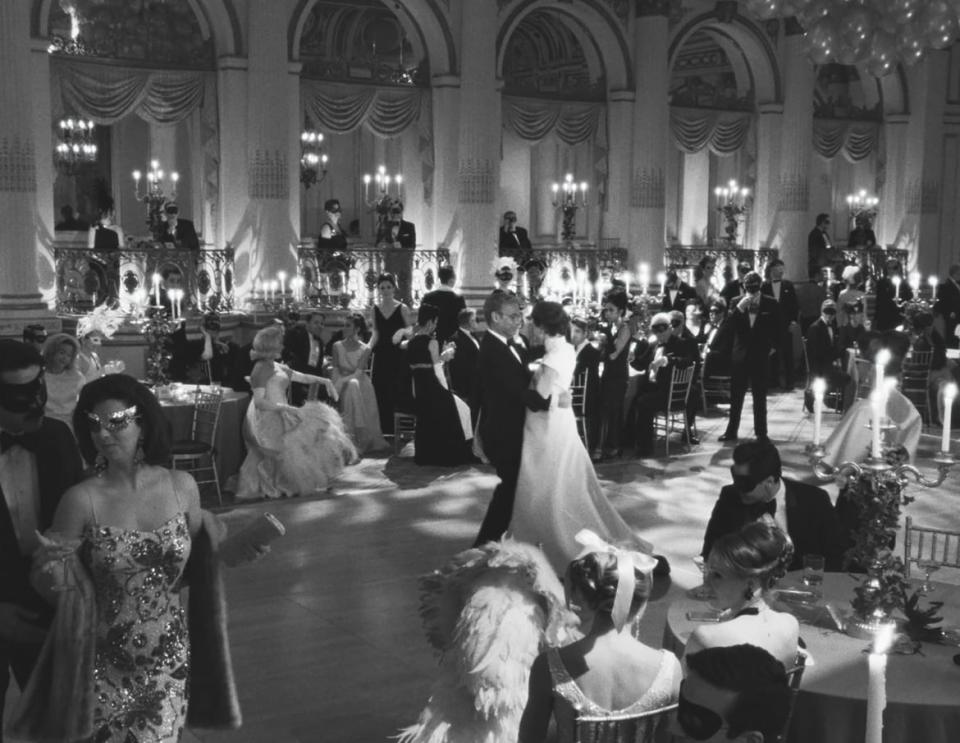How ‘Capote vs. the Swans’ Predicted Everything About 2024 Culture

- Oops!Something went wrong.Please try again later.
- Oops!Something went wrong.Please try again later.
- Oops!Something went wrong.Please try again later.
- Oops!Something went wrong.Please try again later.
- Oops!Something went wrong.Please try again later.
- Oops!Something went wrong.Please try again later.
The 1975 social scene of Feud: Capote vs. The Swans reminds viewers that 2024’s Real Housewives are amateurs at shade, gossip, and holding a grudge. The first two episodes, now streaming on FX and Hulu, recapture when Esquire magazine was that era’s Bravo.
Truman Capote (Tom Hollander) betrayed his friends and destroyed his social status with Esquire’s late-October publication of “La Côte Basque, 1965”—a fictional story splaying out real-life scandals from the lives of high society’s wealthy “swans.”
“I am always listening,” Capote rationalizes in Feud, “I am recording, because this is the way of the world.”
The Daily Beast’s Obsessed looked back to Capote’s world of October 1975, and how events of that month influenced 2024. Capote focused on “high society,” while modern society’s roots took hold around him.
Some comparisons are clear—Feud’s first major scene features Capote comforting Babe Paley (Naomi Watts) about her husband Bill’s (Treat Williams) affair with New York’s first lady. Capote and Paley’s status might be higher, but the emotion is like Vanderpump Rules’ Ariana Madix venting to Katie Maloney about Ariana’s wandering beau Tom Sandoval.

Naomi Watts as Barbara “Babe” Paley, and Tom Hollander as Truman Capote, in Feud: Capote vs. The Swans.
Madix used every detail of Sandoval’s betrayal to springboard onto new projects. Babe Paley felt horrified as her husband’s infidelities became public gossip.
Whether among A-listers or wannabes, Capote never missed romantic deceptions. October 1975 had days full of significant moments all within Capote’s orbit, but some were just beneath his notice.
Neil Simon had recruited Capote to star in Murder by Death, a “grotesque little farce,” snipes Lee Radziwill (Calista Flockhart). On set that October, Capote worked with Alec Guinness, who had little use for Capote’s “godawful” acting chops.

Truman Capote dancing with Lee Radziwill at his Black-and-White Ball at the Plaza Hotel, New York, in November 1966.

Feud: Capote vs. The Swans “The Black and White Ball” episode.
A script arrives at Guinness’ dressing room. A lunch is arranged between the respected actor and a rising director—an “intense” young man, Guinness noted. The science-fiction script is confusing, Guinness thinks, but intriguing in its commitment.
George Lucas, the director, is in Hollywood to fight for funding as 20th Century Fox feels cold feet about his expensive creative vision. Lucas has other options. On Oct. 13, Marcia Nasatir memos her boss at United Artists that if opportunity arises, UA should pursue The Star Wars: “I like this very much,” Nasatir writes. “The story… makes for the best kind of motion picture.”
Capote captured the stories of his present. Few foresaw Star Wars telling stories for another 50 years.
“A story is everything…”
In Feud, Capote holds court at a fancy dinner. “I think [a story] is everything,” he says, “but it’s not all fun and games. We’ve been talking about society, but I’m interested in what it all means, really, to be important.”
Murder by Death rehearsals had just begun at the Burbank studios when the Oct. 12, 1975, Los Angeles Times featured full-page advertisements for Bruce Springsteen’s six shows at the Roxy on the Sunset Strip, and the premiere of Mahogany starring Diana Ross.
Springsteen’s single “Born to Run” had just peaked at Number 3 on Billboard’s Hot 200 chart. Mahogany followed Ross’ 1972 Oscar-nominated performance in Lady Sings the Blues. In 1975, a Black woman—a music star, an actress, a fashion designer—could headline her own movie. Claudine had earned Diahann Carroll her own Oscar nomination that spring, and Carroll and Ross were breaking through. On Oct. 20, Time and Newsweek arrived on newsstands, featuring Springsteen on both covers.

Chloë Sevigny as C.Z. Guest, Naomi Watts as Babe Paley, Diane Lane as Slim Keith, in Feud: Capote vs. The Swans.
In 1975, mass media enabled four-corners dominance in brand-new ways. Today, Beyonce and Taylor Swift share that important superpower—a gravity capturing all the culture they touch.
Springsteen outlasted Time and Newsweek’s relevance. Swift used Ross’ roadmap to consume even the behemoth of the National Football League.
The ‘Capote vs. the Swans’ Cast Dish on Making TV’s Juiciest New Series
The NFL can thank major league baseball, and Carlton Fisk in Oct. 1975, for today’s sports dominance of the entertainment industry.
Fisk, the Boston Red Sox catcher, won Game Six of the World Series with a home run in Oct. 22’s early morning. The triumph played out in full-color shock and awe—a perfect scene for decades of replays. The homer only won the game, as the Red Sox lost Game Seven to the Cincinnati Reds. But televised sports changed forever, after Fisk’s iconic dance willed his home run fair.
Other dancers shared the backside of Fenway’s Green Monster. That October, Steve Rubell worked with a group opening the new 15 Lansdowne nightclub, featuring a 15-foot-wide disco ball.
It took a few years before Rubell ruled New York City from the velvet rope of Capote and C.Z. Guest’s late-’70s hangout, Studio 54 (shown in an awkward Feud scene), before disco’s mesmerizing rhythm revolutionized music. In October 1975. Donna Summer’s “Love to Love You Baby” had just entered the disco charts, an erotic secret except to sweaty dancers, though not for much longer.
Mainstream music fans awaited the second episode of NBC’s new live comedy series, Saturday Night Live, featuring the Oct. 18 reunion of Simon and Garfunkel.
“Why is it so fucking hard for everyone to accept the idea that society is filled with secrets, and lies, and allegiances, and innuendos, and that was worth… exposing,” Capote says in a self-justifying Feud rant. The pause before “exposing” is small, like he wanted a different word but couldn’t catch himself in time. Like he feels bad, revealing his social circle’s fragile mysteries.
Paul Simon and Art Garfunkel’s allegiance is full of exposed feelings, even in gentle insults as they shared SNL’s stage that October night. Capote understood jealousy—how Garfunkel felt marginalized as just a high note, how Simon resented Garfunkel getting cheers for words that Simon wrote, all mirrored in how Norman Mailer won awards for using writing styles Capote felt he had originated.
Simon and Garfunkel—breakups and reunions, now and then. Saturday Night Live’s ever-changing lineup enabled one of TV’s most influential programs for the next 50 years, cocaine-fueled energy and creative rivalries, barging into living rooms.
Between John Belushi versus Jane Curtin, Tina Fey versus Sarah Palin, and Chevy Chase versus everybody, Saturday Night Live featured plenty of feuds since its Oct. 11, 1975 premiere—enough drama for an upcoming fictionalized series of its own.
“Did you see this moment?”
Bad blood pools behind closed doors.
“Is there anything you know that we don’t?” Bill Paley, the head of the CBS television network, asks Capote in the Feud premiere.
Truman answers the question by revealing a covered-up murder.
Ann Woodward (Demi Moore), a social climber from Kansas, had shot her millionaire husband, believing he was a burglar breaking into their Oyster Bay mansion. Capote claims it was straight-up murder, and the notorious Ann “Bang, Bang” Woodward got away with it because her mother-in-law paid off the police to avoid scandal. The incident is examined in Roseanne Montillo’s Deliberate Cruelty, while the series Feud is based on Lawrence Leamer’s Capote’s Women.
Bill Paley didn’t know details about the Woodward scandal; he knew television.
“You know the chessboard,” Babe says to him. “You’re so many moves ahead of Truman and me. Did you see this moment?”
She meant the revelation of his tawdry behavior. The question also fits 1975’s changing media.
Television faced a threat from the product advertised in the Oct. 19 Los Angeles Times—the Sony Betamax cassette recorder. According to the ad, “commercials can be omitted from tapes.”
‘Capote vs. the Swans’ Is a Gloriously Bitchy Real ‘Real Housewives’
The networks faced a threat from the new pay channel HBO, which had just broadcast the Oct. 1 Ali-Frazier fight on pay-per-view. On Oct. 21, HBO licensed an outside production for the first time, the BBC Victorian Era melodrama The Pallisers—paying $500,000 to build up subscriber content.
Threats went beyond the Big Three networks of CBS, ABC, and NBC. The Oct. 13 issue of Box Office magazine had the headline: “Exhibitors See Pay-Cable Television as Threat to Theatre Business.”
In 1975, movie theaters printed money. Whether Mahogany’s midnight showings, the new Al Pacino star vehicle Dog Day Afternoon, or Jaws still filling seats a year after its release, movies were bigger than ever.
Some experiments didn’t work. The campy Rocky Horror Picture Show played to decent Los Angeles crowds that October, though tepid response elsewhere. Cute idea, but no one thought it had legs.
Producers learned to repeat what worked, while some claimed to resist.
Jaws director Steven Spielberg told an Oct. 16 film festival audience that he’d already passed on directing a Jaws II.
“Making a sequel,” Spielberg mocked, “is just a cheap carny trick.”
What is gossip, except a low-rent sequel? A story told again and again, in desperation for better insults and more salacious detail.
Capote needed to jumpstart his self-proclaimed masterpiece, Answered Prayers. After a lunch of exuberant backstabbing among the socialite Swans, Capote’s then-lover John O’Shea (Russell Tovey) tells Capote to use it as source material, “You’re not blocked. Look at what you got.”
The comment inspires Capote to use lunchtime gossip from socialites like Slim Keith (Diane Lane), C.Z. Guest (Chloë Sevigny), Paley and Radziwill, or his California friend, Joanne Carson (Molly Ringwald).
Which leads to “La Côte Basque, 1965.”
Ann Woodward died of an overdose on Oct. 10—a copy of “La Côte Basque, 1965” supposedly in her hands. The story presented “Ann Hopkins” as a bigamist, a murderess, a notorious figure cast out of her social world. As the legend goes, she couldn’t bear to see the 1955 shooting incident exploited in Capote’s theft of her life.
On Oct. 22, Capote spoke at Albuquerque’s University of New Mexico. Newspapers promoted his visit next to ads for Deep Throat and The Devil in Miss Jones.
About two miles away from UNM’s Popejay Hall, editors of the MITS Computer Notes newsletter prepared for an Oct. 24 mailing to its audience of technical hobbyists interested in Micro Instrumentation and Telemetry Systems’ new BASIC computer language.
One of the language’s developers, Bill Gates, wrote a newsletter column describing a programming process for the Altair 8800 computer. In another section, MITS president H. Edward Roberts criticized those who pirated copies of BASIC.
“We made a $180,000 royalty commitment to Micro Soft in order to have BASIC available to our customers,” Roberts wrote in the October newsletter, maybe the first time ‘Micro Soft,’ later Microsoft, appeared in public print. “Anyone using a stolen copy of MITS BASIC should identify himself for what he is, a thief.”
‘Feud: Capote vs. the Swans’ Recap: Why Do All These Women Hate Truman Capote?
A “thief,” the Swans called Capote—but like an admirer says, Capote never needed to steal; he seduced.
“I would never let a storyteller have the last word,” another socialite accuses Capote.
“Tell me, dear,” Capote asks, “who should have the last word?”
“It’s perfectly obvious. The person who has the most power,” in finance, military, geopolitics. As she said, obvious.
The last word, Capote knew, is held by what’s strongest of all.
“No,” he said. “It’s memory.”
From October 1975, the last word goes to what we can’t forget—Diana Ross and Bruce Springsteen, HBO, SNL and Star Wars, Bill Gates and the Boston Red Sox. Finally, Feud; Truman Capote and the Swans waltzing back through the door, looking better than a body has a right to.
Get the Daily Beast's biggest scoops and scandals delivered right to your inbox. Sign up now.
Stay informed and gain unlimited access to the Daily Beast's unmatched reporting. Subscribe now.

